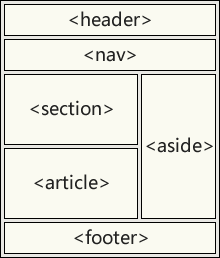HTML5 語義元素-4.4HTML5
閱讀 ?·? 發布日期 2019-07-11 12:32 ?·? admin語義學(源自古希臘)可定義為對語言意義的研究。
語義元素是擁有語義的元素。
什么是語義元素?
語義元素清楚地向瀏覽器和開發者描述其意義。
非語義元素的例子:<div> 和 <span> - 無法提供關于其內容的信息。
語義元素的例子:<form>、<table> 以及 <img> - 清晰地定義其內容。
瀏覽器支持
| Yes | Yes | Yes | Yes | Yes |
所有現代瀏覽器均支持 HTML5 語義元素。
此外,您可以“幫助”老式瀏覽器處理“未知元素”。
在 HTML5 瀏覽器支持這一章學習更多知識。
HTML5 中新的語義元素
許多網站包含了指示導航、頁眉以及頁腳的 HTML 代碼,例如這些:<div id="nav"> <div class="header"> <div id="footer">。
HTML5 提供了定義頁面不同部分的新語義元素:
- <article>
- <aside>
- <details>
- <figcaption>
- <figure>
- <footer>
- <header>
- <main>
- <mark>
- <nav>
- <section>
- <summary>
- <time>
HTML5 語義元素

HTML5 <section> 元素
<section> 元素定義文檔中的節。
根據 W3C 的 HTML 文獻:“節(section)是有主題的內容組,通常具有標題”。
可以將網站首頁劃分為簡介、內容、聯系信息等節。
實例
<section>
<h1>WWF</h1>
<p>The World Wide Fund for Nature (WWF) is....</p>
</section>
HTML5 <article> 元素
<article> 元素規定獨立的自包含內容。
文檔有其自身的意義,并且可以獨立于網站其他內容進行閱讀。
<article> 元素的應用場景:
- 論壇
- 博客
- 新聞
實例
<article>
<h1>What Does WWF Do?</h1>
<p>WWF's mission is to stop the degradation of our planet's natural environment,
and build a future in which humans live in harmony with nature.</p>
</article>
嵌套語義元素
在 HTML5 標準中,<article> 元素定義完整的相關元素自包含塊。
<section> 元素被定義為相關元素塊。
我們能夠使用該定義來決定如何嵌套元素嗎?不,我們不能!
在因特網上,您會發現 <section> 元素包含 <article> 元素的 HTML 頁面,還有 <article> 元素包含 <sections> 元素的頁面。
您還會發現 <section> 元素包含 <section> 元素,同時 <article> 元素包含 <article> 元素。
HTML5 <header> 元素
<header> 元素為文檔或節規定頁眉。
<header> 元素應該被用作介紹性內容的容器。
一個文檔中可以有多個 <header> 元素。
下例為一篇文章定義了頁眉:
實例
<article>
<header>
<h1>What Does WWF Do?</h1>
<p>WWF's mission:</p>
</header>
<p>WWF's mission is to stop the degradation of our planet's natural environment,
and build a future in which humans live in harmony with nature.</p>
</article>
HTML5 <footer> 元素
<footer> 元素為文檔或節規定頁腳。
<footer> 元素應該提供有關其包含元素的信息。
頁腳通常包含文檔的作者、版權信息、使用條款鏈接、聯系信息等等。
您可以在一個文檔中使用多個 <footer> 元素。
實例
<footer>
<p>Posted by: Hege Refsnes</p>
<p>Contact information: <a href="mailto:someone@example.com">
someone@example.com</a>.</p>
</footer>
HTML5 <nav> 元素
<nav> 元素定義導航鏈接集合。
<nav> 元素旨在定義大型的導航鏈接塊。不過,并非文檔中所有鏈接都應該位于 <nav> 元素中!
實例
<nav>
<a href="/html/">HTML</a> |
<a href="/css/">CSS</a> |
<a href="/js/">JavaScript</a> |
<a href="/jquery/">jQuery</a>
</nav>
HTML5 <aside> 元素
<aside> 元素頁面主內容之外的某些內容(比如側欄)。
aside 內容應該與周圍內容相關。
實例
<p>My family and I visited The Epcot center this summer.</p>
<aside>
<h4>Epcot Center</h4>
<p>The Epcot Center is a theme park in Disney World, Florida.</p>
</aside>
HTML5 <figure> 和 <figcaption> 元素
在書籍和報紙中,與圖片搭配的標題很常見。
標題(caption)的作用是為圖片添加可見的解釋。
通過 HTML5,圖片和標題能夠被組合在 <figure> 元素中:
實例
<figure>
<img src="pic_mountain.jpg" alt="The Pulpit Rock" width="304" height="228">
<figcaption>Fig1. - The Pulpit Pock, Norway.</figcaption>
</figure>
<img> 元素定義圖像,<figcaption> 元素定義標題。
為何使用 HTML5 元素?
如果使用 HTML4 的話,開發者會使用他們喜愛的屬性名來設置頁面元素的樣式:
header, top, bottom, footer, menu, navigation, main, container, content, article, sidebar, topnav, ...
如此,瀏覽器便無法識別正確的網頁內容。
而通過 HTML5 元素,比如:<header> <footer> <nav> <section> <article>,此問題迎刃而解。
根據 W3C,語義網:
“允許跨應用程序、企業和團體對數據進行分享和重用。”
HTML5 中的語義元素
下面列出了以字母順序排列的 HTML5 新語義元素。
這些鏈接指向完整的 HTML 參考手冊。
| 標簽 | 描述 |
|---|---|
| <article> | 定義文章。 |
| <aside> | 定義頁面內容以外的內容。 |
| <details> | 定義用戶能夠查看或隱藏的額外細節。 |
| <figcaption> | 定義 <figure> 元素的標題。 |
| <figure> | 規定自包含內容,比如圖示、圖表、照片、代碼清單等。 |
| <footer> | 定義文檔或節的頁腳。 |
| <header> | 規定文檔或節的頁眉。 |
| <main> | 規定文檔的主內容。 |
| <mark> | 定義重要的或強調的文本。 |
| <nav> | 定義導航鏈接。 |
| <section> | 定義文檔中的節。 |
| <summary> | 定義 <details> 元素的可見標題。 |
| <time> | 定義日期/時間。 |
為您推薦
-
襯塑管網站建設_網頁定制制作與開發 2020-01-12
-
保溫管網站建設_網頁定制制作與開發 2020-01-12
-
玻璃管網站建設_網頁定制制作與開發 2020-01-12
-
鍍鋅方矩管網站建設_網頁定制制作與 2020-01-12
-
PVC管材網站建設_網頁定制制作與開發 2020-01-12


